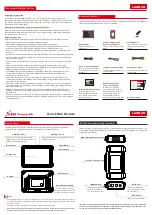
15
Checking socket outlets and connecting wires
The test is the same for both socket outlets and connecting
wires. For this reason, only socket outlets are mentioned in
this documentation.
The device is very easy to operate: turn the switch
S1
to
OFF
,
and plug the device into the socket outlet to be tested. You
should ensure that the phase conductor connects to the left-
hand pin (viewed when device is inserted and faceplate visi-
ble).
Checking the correct position
The device is ready to use for testing when the touch elec-
trode is touched and the lamp
GL1
lights up. If it doesn’t,
either the device has been incorrectly inserted or the socket
outlet has been incorrectly wired. Rotate the Schuki 2 180°,
then re-insert into the socket and re-check the positioning.
No fault determined
Figure 2: All lamps in the yellow area light up. The lamp
GL1
must light up when the touch electrode is touched.
You must observe the fault depicted in figure 9.
14
Figure 1: Schuki 2
Control elements
Two elements available for testing the ELCB circuitry.
y
(S1) Rotary switch to adjust the nominal fault current
y
(T)
A button to trigger the nominal fault current
The touch electrode tests the phase conductor according to
the principle of a phase tester.
Symbols used in this documentation
To provide a better overview, images are used to enhance the
descriptions of faults. For this purpose, the following symbols
are used:
y
Symbol not shaded:
The lamp is not glowing or the button has not been pressed
y
Symbol shaded:
The lamp lights up or the button has been pressed
y
Plug symbol for test results:
The recognised circuitry is portrayed.
y
Danger symbols:
The recognised circuit is
a danger to life.
Schuki 2 22.01.2004 15:49 Uhr Seite 14









































